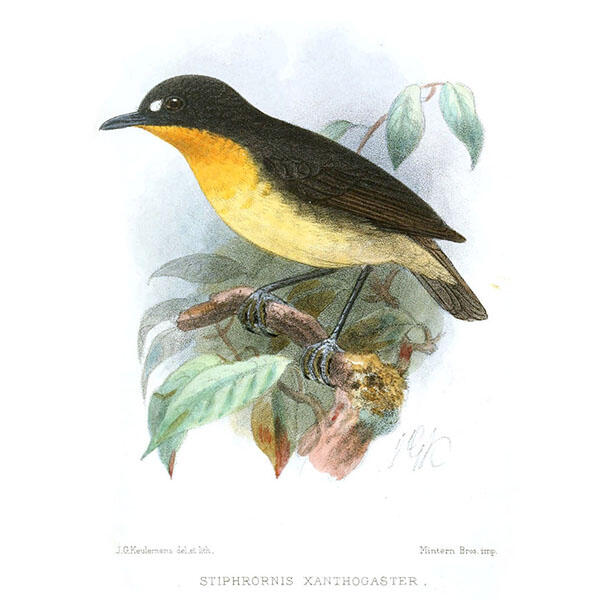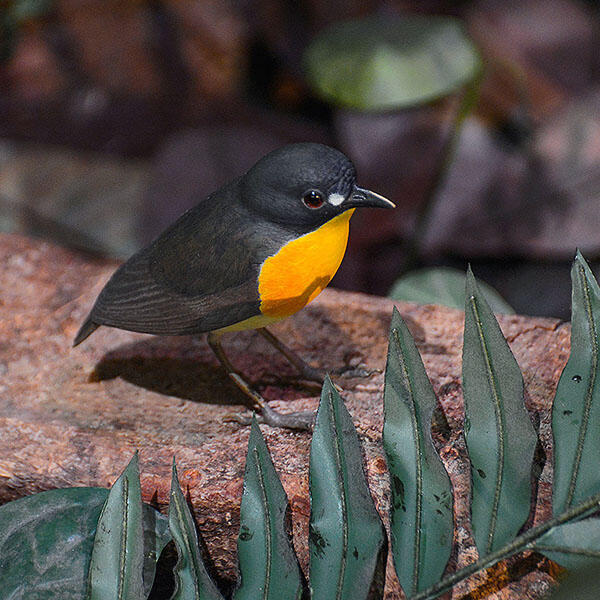Discoveries in Dioramas
© AMNH
Consider the dioramas, which since the early 1900s were designed to represent a down-to-the-dirt accurate scene—to bring visitors along to a crowded watering hole or to a quiet forest clearing thousands of miles away. “The dioramas at the American Natural History Museum, when they were first built, were an opportunity for people to see a world that most didn’t get to travel to,” says Evon Hekkala, a professor at Fordham University and a Museum research associate. “They’re beautiful visual depictions of a place and a time in history, but they’re also part of the archive of our planet.”
© AMNH
That’s in large part because most were developed with materials from comprehensive expeditions, on which gathering data and specimens for the scientific collections went hand-in-hand with documenting details that would bring exhibits to life back in New York. No job was too small or too smelly, whether it was sketching leaves or collecting scat (See: virtual reality, early 20th century).
Even a relatively new diorama, like the walk-through Dzanga-Sangha Rainforest in the Hall of Biodiversity, is accurate down to the tiniest twigs and muddy elephant footprints thanks to multi-tasking scouting trips. Joel Cracraft, Lamont Curator in the Department of Ornithology, was part of the expedition team to the Central African Republic in the 1990s and encountered many species while in the field that are now represented in the exhibit. One was a small forest robin. It didn’t boast the fascinating feathers of some rainforest birds, and almost flew under the radar. “We thought it was just a normal old forest robin,” says Cracraft.
 A 1905 illustration depicts an Eastern Forest Robin (Stiphrornis erythrothorax xanthogaster), found in Central and West Africa.
A 1905 illustration depicts an Eastern Forest Robin (Stiphrornis erythrothorax xanthogaster), found in Central and West Africa.Courtesy of J. G. Keulemans/Wikimedia
 Stiphrornis sanghensis, the Sangha Forest Robin, was discovered on a scouting trip for a Museum exhibition.
Stiphrornis sanghensis, the Sangha Forest Robin, was discovered on a scouting trip for a Museum exhibition.R. Mickens/© AMNH
Back at the Museum, however, careful analysis of DNA samples, plumage, and vocalizations by Cracraft and a colleague revealed the nondescript bird as a whole new species—Stiphrornis sanghensis, the Sangha Forest Robin. It turned out that, in the course of developing a diorama, the researchers had made a bona fide scientific discovery. Sharp-eyed visitors can get a glimpse of a model of the bird as they walk through the Dzanga-Sangha diorama. (Hint: Look at the feet of a tree to the left of the elephant dung.)
It’s not just new dioramas that can spur discoveries. Many taxidermy sculptures created in the 1900s were mounted on metal armatures, while the corresponding skeletons were preserved in the scientific collections. Now, researchers are finding new ways to analyze these decades-old specimens using modern techniques and technologies.
J. Kirschner/© AMNH
In 2011, for example, Hekkala and a team of researchers began analyzing DNA from Nile crocodile specimens, including a mummified crocodile held in the collections of the Muséum national d'Histoire naturelle in Paris and specimens from the collections of the American Museum of Natural History. If you look closely at the watering hole shown in the Upper Nile diorama, you can see—not far from the feet of a yawning hippo—a Nile crocodile that makes up part of the bustling scene. Hekkala and her colleagues used DNA from the skeleton of that specimen, which has been housed upstairs in the collections since it was brought back to New York in the early 1900s, as well as dozens of others to come to a new understanding of how African crocodiles are related.
The result was the surprising finding that the Nile crocodile is not one species, as thought for more than 100 years, but two: the known Crocodylus niloticus and an ancestral western species, Crocodylus suchus. And thanks to the advent of new DNA analysis techniques that can shine light on decades-old specimens, this type of scientific investigation is just the beginning.
“Natural history specimens are collected in a moment, but as time passes, we get new sets of tools we can use to explore them over and over again,” says Hekkala “We never know in that first moment how valuable a specimen will be in the future. They have a seemingly endless ability to transform into new tools for understanding our changing world.”
There's more to some century-old collections than meets the eye in Episode 16: Tales from the Cryptic Species.